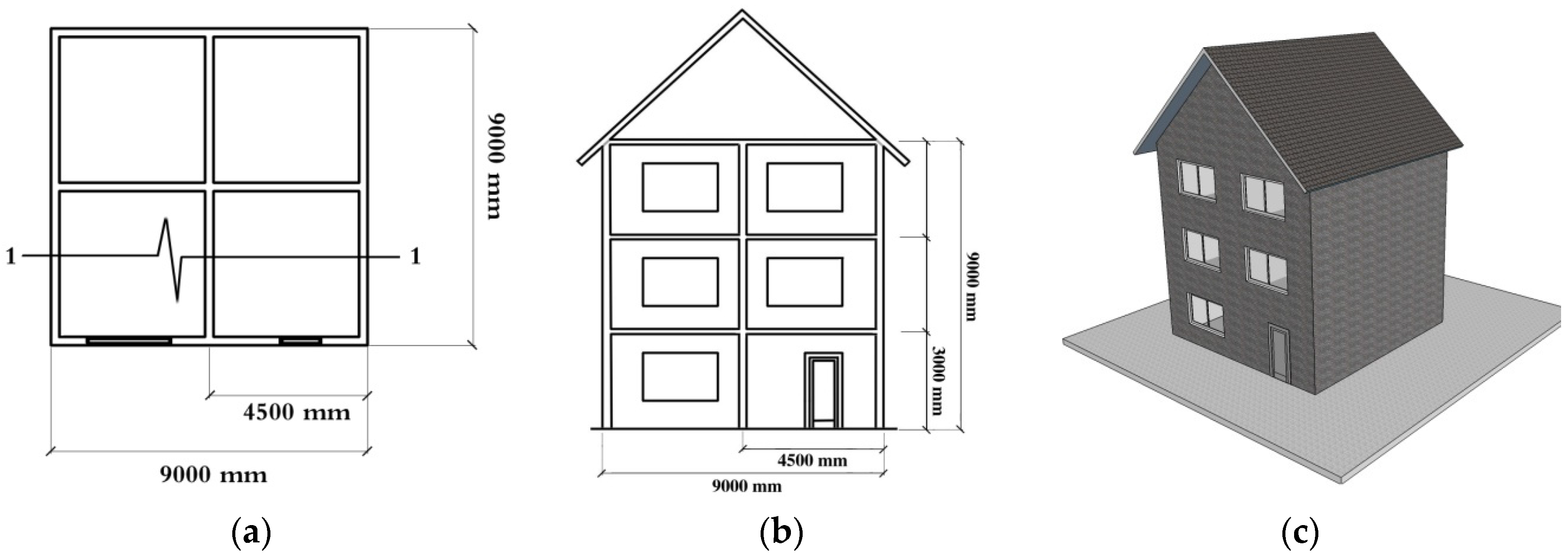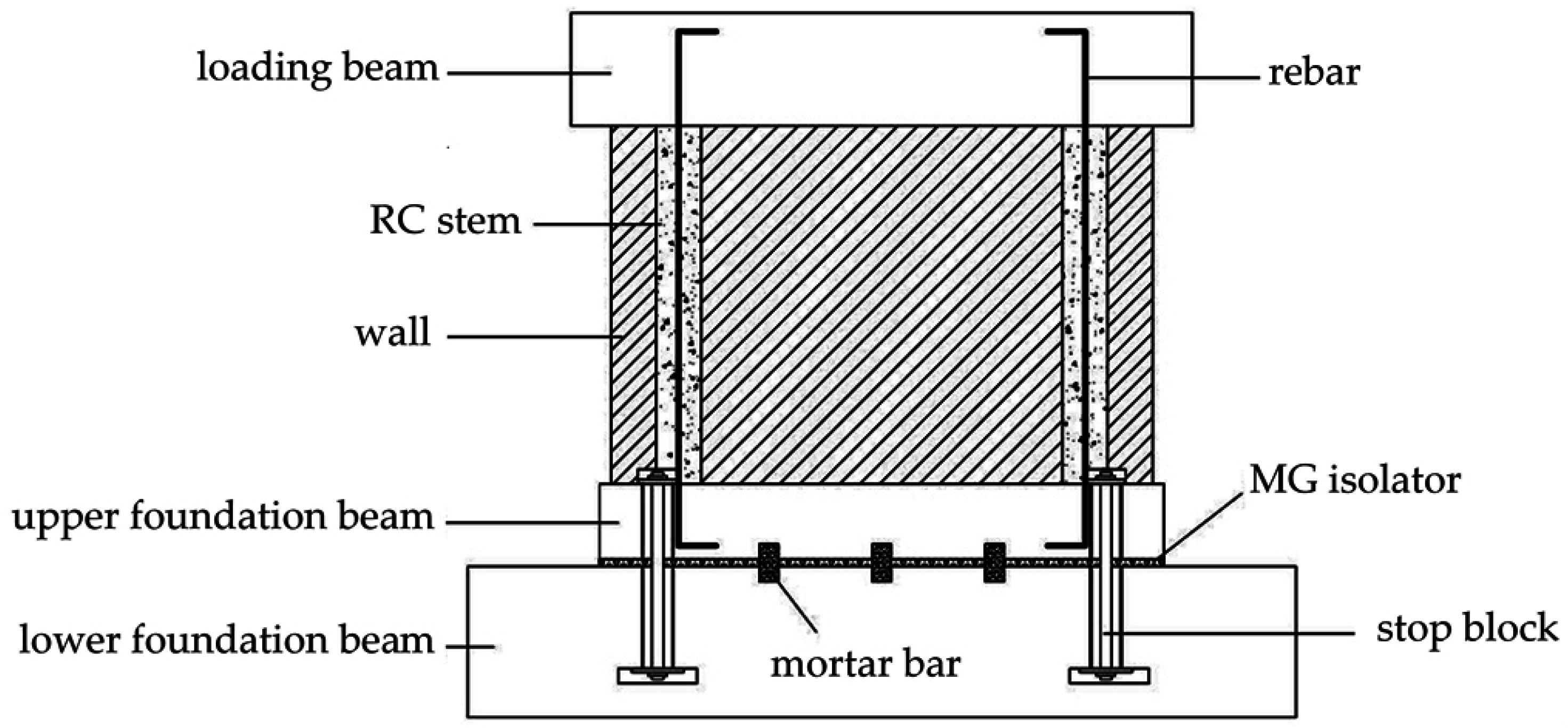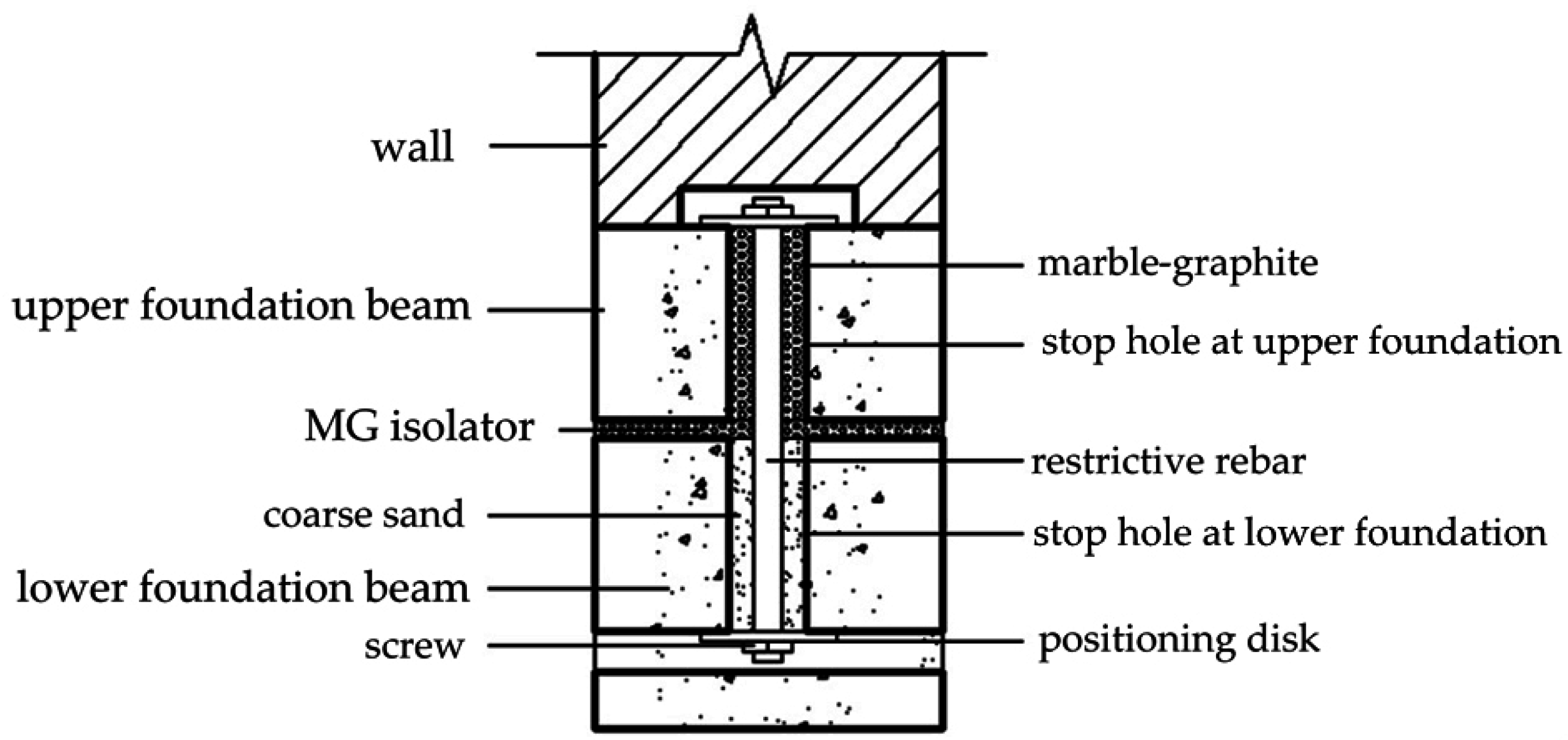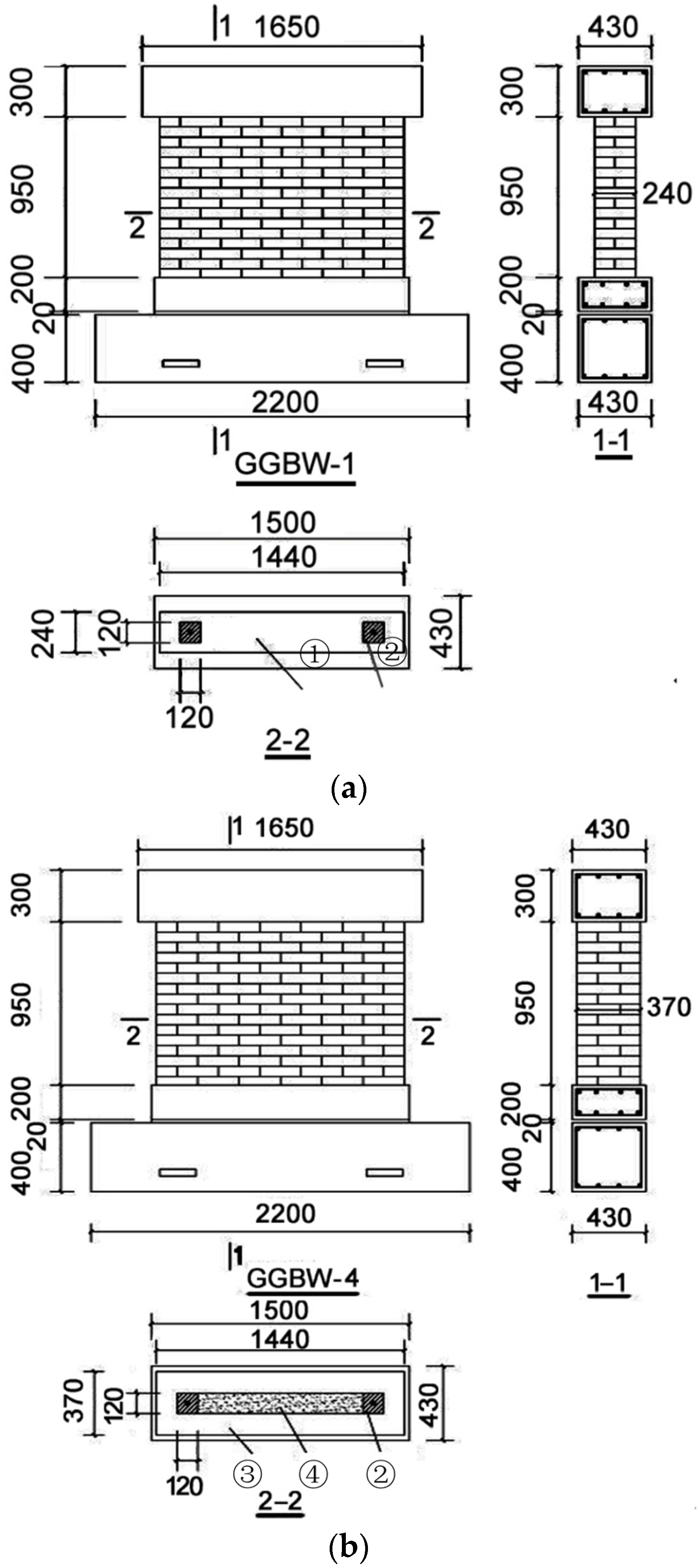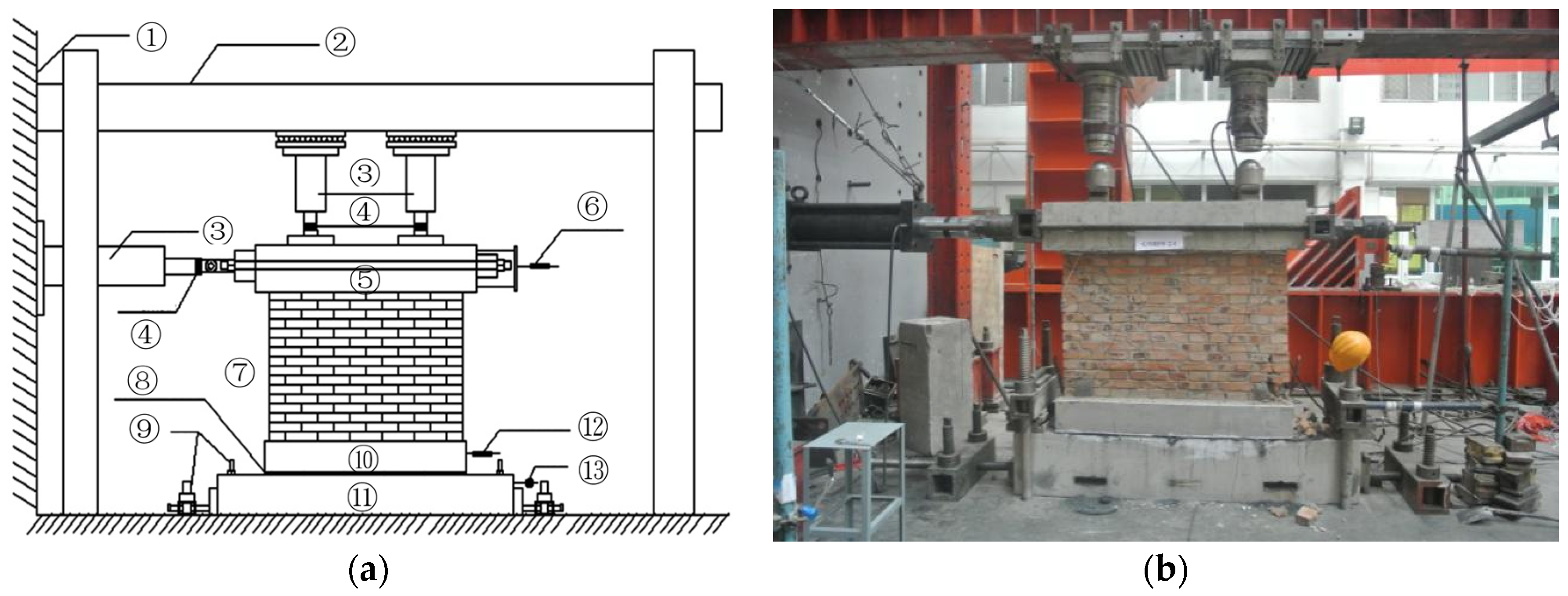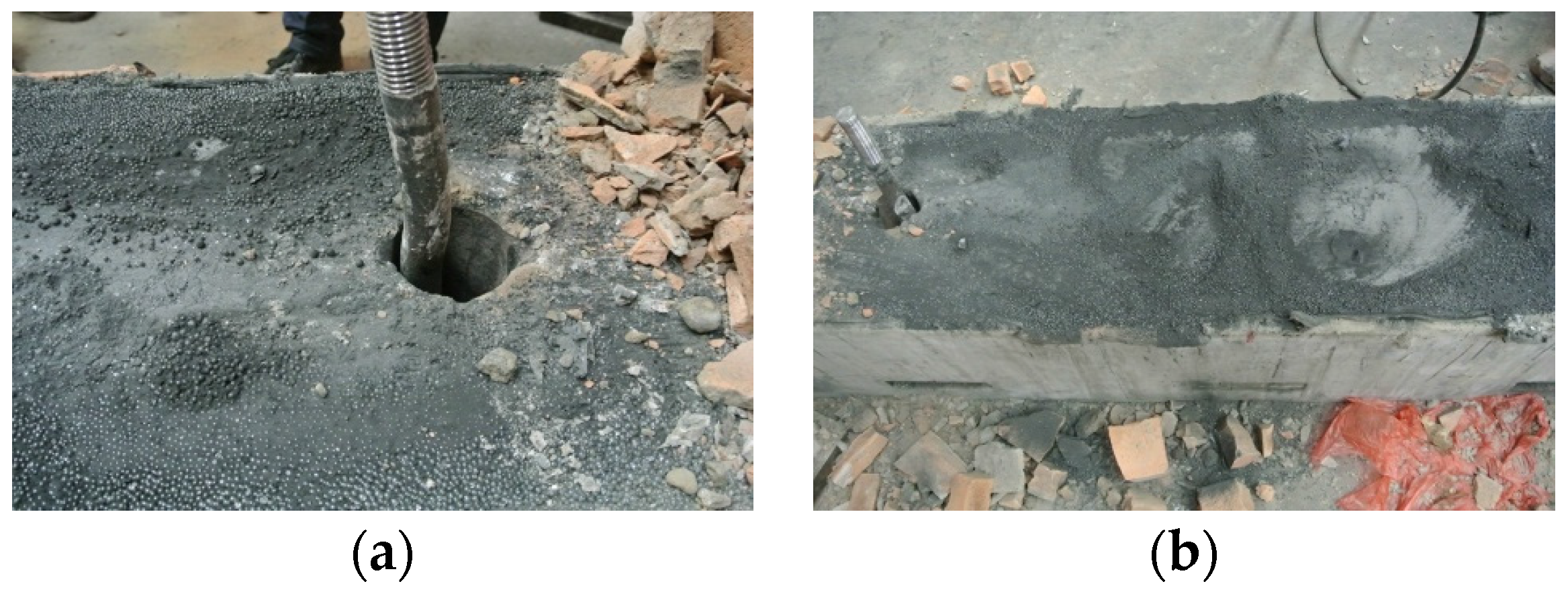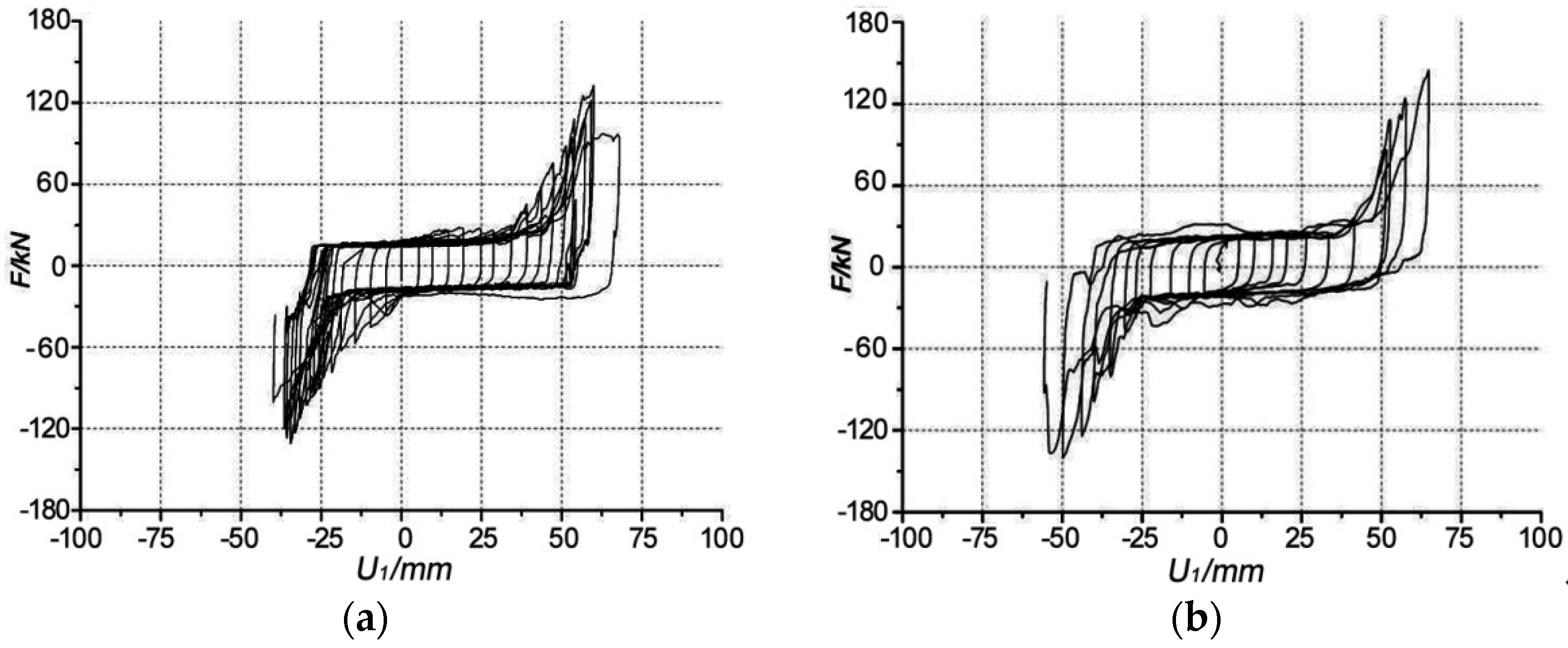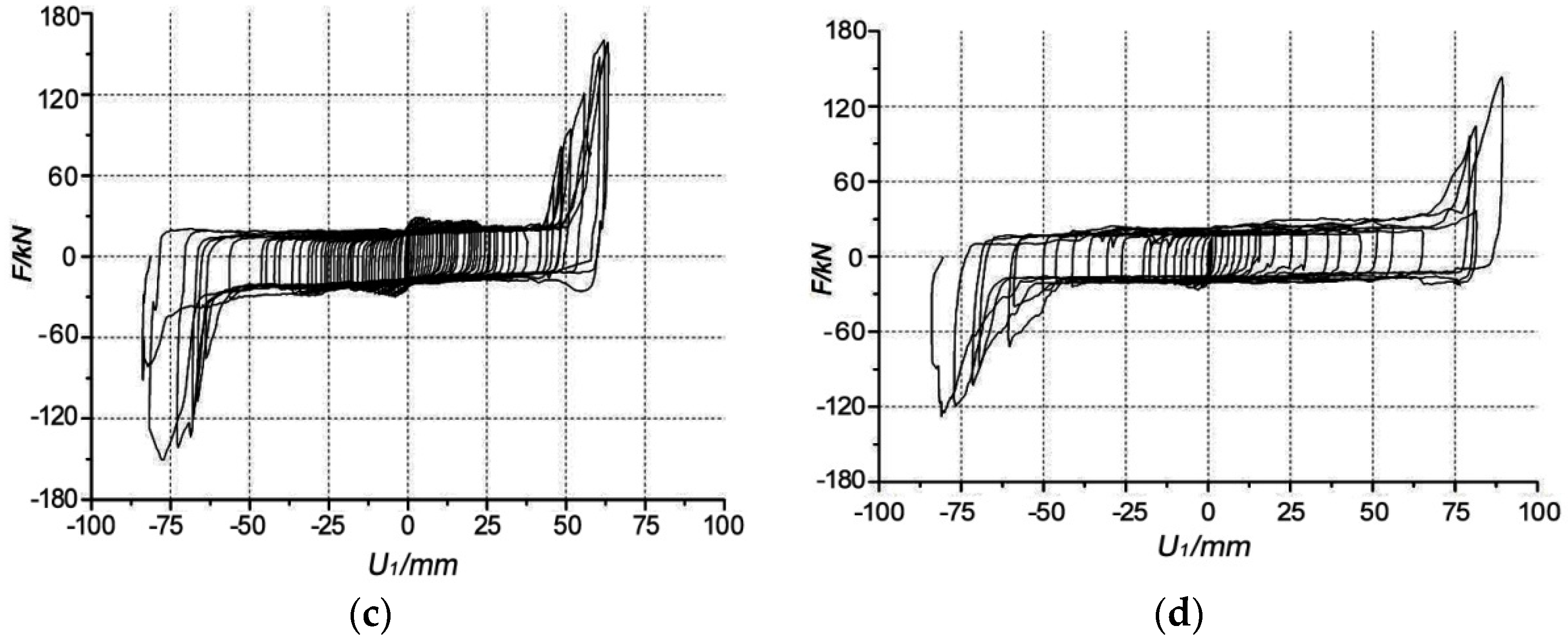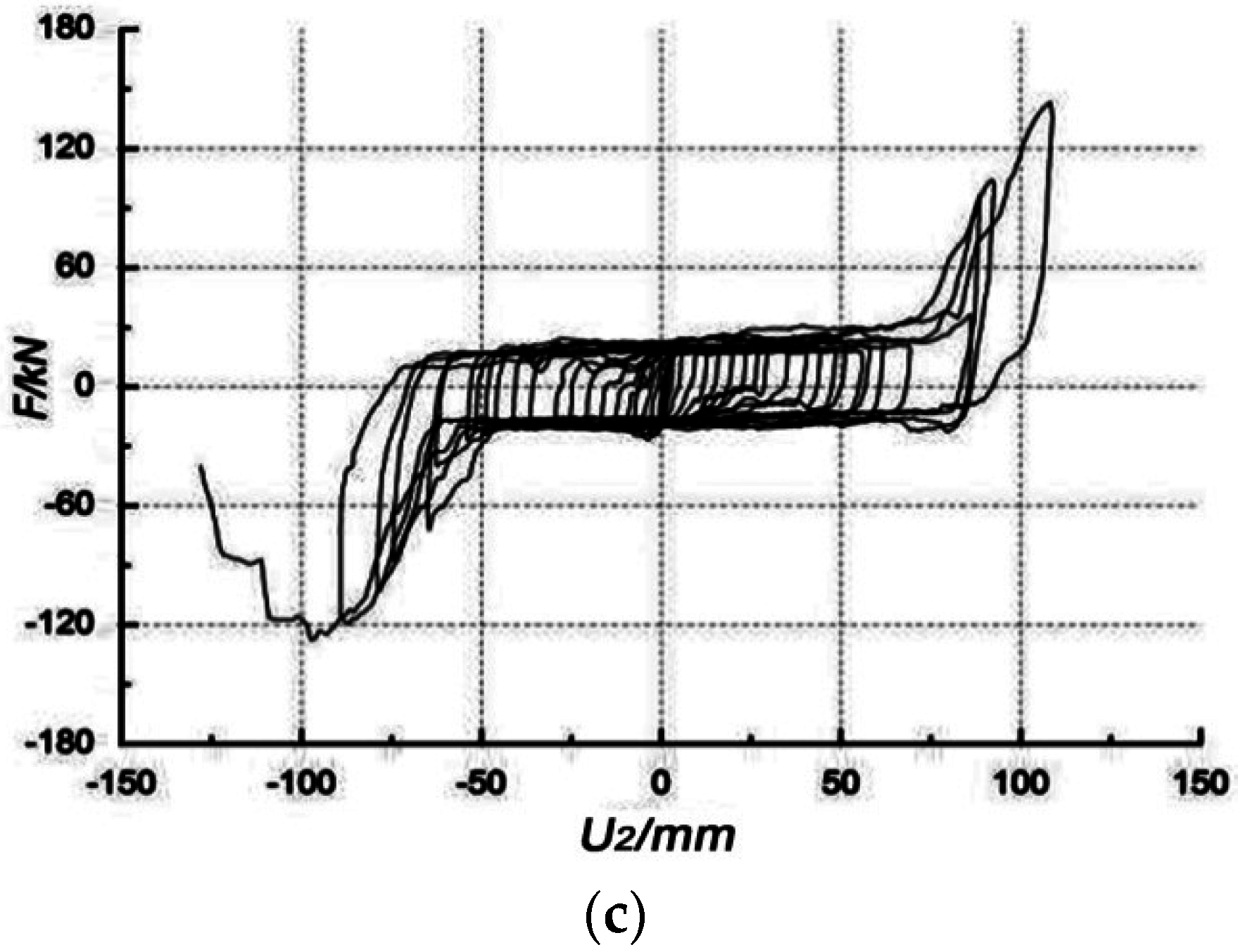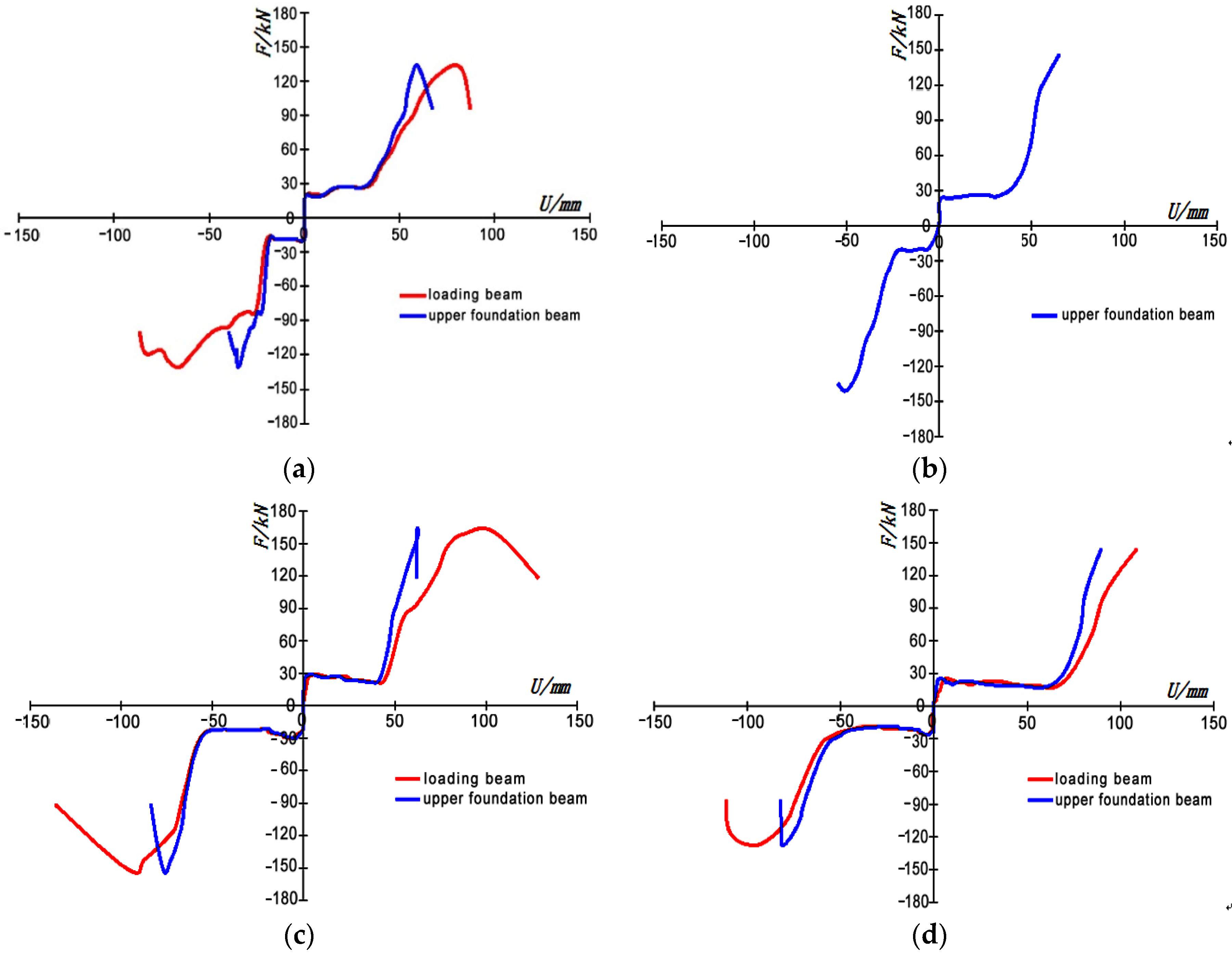1. Introduction
Low-rise masonry residential structures are a widely used engineering design, but are these structures are frequently damaged by earthquakes, leading to numerous casualties and severe property loss. Seismic isolation offers a solution to this problem, but the focus has typically been on multi-storey masonry buildings. The design solutions include friction sliding bearings, laminated rubber bearings or lead rubber bearings, which offer exceptional isolating performance but also lead to high costs and complex engineering. Therefore, engineering researchers and practitioners have been working earnestly to develop an economical seismic isolation system that involves straightforward engineering for low-rise masonry buildings.
Milestones in this research are highlighted in this section. Zimmermann et al. [
1], analysed the structural behaviour of low- and normal-strength interface mortar for masonry. Zimmermann and Strauss [
2,
3] performed a numerical investigation of historic masonry walls under normal and shear load and studied the capacity of old brick masonry with regard to cyclic stress. Salmanpour [
4], carried out cyclic quasi-static tests on full-scale unreinforced masonry walls made of clay and calcium silicate blocks to investigate the effects of the various factors. The results showed that due to the formation of a sliding mode in the calcium silicate walls, the unreinforced masonry walls were able to exhibit a higher deformation and energy dissipation capacity compared to the clay walls. Nanda et al. [
5], studied four friction isolation interfaces, namely, marble–marble, marble–high density polyethylene, marble–rubber sheet, and marble–geosynthetic. For marble–marble and marble–geosynthetic interfaces, a greater than 50% reduction in absolute response acceleration at the roof level could be achieved in comparison with the response of the fixed-base structure at the cost of increasing the relative sliding displacements at the friction interface. Nanda et al. [
6], proposed four different sliding interfaces, namely green marble/high density poly ethylene (HDPE), green marble/green marble, green marble/geosynthetic, and green marble/rubber layers, which had been studied in experimental and analytical investigations. Green marble and geosynthetic layers were found to be the better alternatives for use in a friction isolation system with equal effectiveness for energy dissipation as they limit the earthquake energy transmission to the superstructure during a strong earthquake, making the green marble and geosynthetic layers a low-cost durable solution for earthquake protection of masonry buildings. Zhang, el al. [
7], put an integrated masonry structure of recycled bricks and adobe with one marble-graphite slide seismic isolator at its foundation into the vibration test rig. The results showed that the isolator delivered sound performance in terms of vibration isolation. Given the great mechanical properties of the overall structure, the straightforward approach of construction and the cost efficiency, the structure can well be applied to the seismic design of low-rise buildings in rural areas. Roussis et al. [
8,
9], developed an seismic isolation bearing in which two sliding friction pendulums linked by a connector interacted orthogonally. The design ensured isolation in the horizontal direction while simultaneously restraining any potential lifting. Koo et al. [
10], studied the impact of buckling loads on the shape factors of lead rubber bearings and showed that horizontal stiffness changes are an important factor in the seismic performance of the bearing. Griffith et al. [
11], embedded a displacement connector within a laminated rubber bearing; the displacement connector restrained any deformation of the bearing when its horizontal displacement exceeded a limit value. Jangid and Kelly [
12], analysed seismic isolation systems in which four distinctive isolators were installed, namely, a classic laminated rubber bearing, a high-damping rubber bearing, a lead rubber bearing and an Electricite-de-France (EDF) bearing. They noticed that the last type displayed better seismic isolation performance during near-fault earthquakes.
Shang et al. [
13], proposed a reinforced asphalt seismic isolation layer structure and applied a simulated earthquake ground motion in an experimental study to analyse the performance of the structure, which was satisfactory. Tsompanakis [
14], performed a finite element analysis of buildings isolated using recycled tires and found that the tire cushion largely mitigated the seismic effects on the superstructure. Due to its cost efficiency, the design using recycled tires can be widely commercialized. Turer [
15], tested scrap automobile tire pads under compressive tests and static shear tests to study the effects of various parameters including the tire orientation and number of layers. The tests showed that the isolator stiffness in both the horizontal and vertical directions could be altered by adjusting the number of tire layers. Turer described the isolator design as a simple, economical and environmentally friendly solution. Tsang [
16], presented the idea of an isolator composed of granulated rubber mixed with soil. An experimental study and numerical simulation were performed to investigate the isolation performance of the structure and its parameters. The results indicated that the design, which is low-cost and easy to construct, largely mitigates the seismic response at the top of the structure.
Nanda [
17], used geotextiles as an isolator in brick masonry buildings and performed a shake-table study. The results were then compared with the experimental outcomes of quake-proofed buildings under the same conditions. The results showed that geotextiles offer great isolation performance based on the large reduction in response acceleration at roof level. Jayalekshmi et al. [
18], presented a base-isolation approach in which fibre-reinforced soil was covered by a geotextile. The design is a practical technique with satisfactory performance. Wang [
19], studied the seismic isolation performance and the shake table results for various sand cushions that varied in grain size and cushion thickness. A specimen consisting of large uniform grains yielded the best performance, and the increase in cushion thickness improved performance.
Yang [
20], proposed slide isolation using a granulated-rubber ceramisite mixture (RCM) in which an RCM isolator was sandwiched between the superstructure and the foundation. In a major earthquake, the energy is dissipated in the slippage and friction at the interface, protecting the superstructure from the direct effects of the event and minimizing damage. The results indicate that the RCM isolation system offers good performance in major earthquakes by reducing the acceleration response of the superstructure. However, the residual displacement of the isolator can be comparatively high. According to this study, the isolation outcomes are controlled mainly by the material properties, component proportions and isolator thickness. Toopchi-Nezhad et al. [
21], conducted a numerical simulation of two-storey masonry buildings with fibre-reinforced elastomeric isolator bearings and compared the results with data obtained from a study of a traditional masonry building. The results showed that the isolation bearing delivers quite stable performance in terms of shear deformation and mitigates the seismic response of the superstructure.
Ahmad et al. [
22], performed a shake table test on a 1/4-scale one-storey masonry building with coarse dry sand as the base isolator. The results were compared with experimental data from the same model without an isolator. The results indicated that the isolator greatly reduced the acceleration response at the top of the structure: no visible cracking occurred even in a major simulated earthquake, whereas cracks formed in the specimen without the isolation base. Following up on this work, Ahmad et al. [
23], performed a shake table test on two 1/4-scale models that were base-isolated using a sheet and coarse dry sand. The results showed that the former design delivered better isolation under the same conditions. Panchal and Jangid [
24], identified an effective solution for improving structural response in near-fault earthquakes, namely the variable friction pendulum system.
Previous research has largely focused on multi-storey buildings such as hospitals, libraries, office buildings and other large public buildings. Although laminated rubber bearings and lead rubber bearings are two well-tested methods of base isolation, their cost and engineering can be burdensome, which is an obstacle to the commercialization of these designs. In comparison, the use of scrap tires, sand, geotextiles, and Poly tetra fluoro ethylene (PTFE) sheets in base isolation, although they are economical and simple alternatives, still requires further study in terms of post-disaster restoration. Therefore, the development of an economical seismic isolator for low-rise buildings is a pressing need that deserves further investigation.
This paper therefore proposes a marble-graphite slide seismic isolation system (MG isolation system), which is unique in its combination of isolation performance, cost effectiveness, stability, durability, waste-recycling potential and straightforward engineering. Due to the spheroid nature of the marbles, embedded marbles work much better as buffer rollers than does coarse sand. In other words, the two qualities shared by graphite and marbles, acceptable engineering cost and stable physiochemical properties, make these materials ideal for base isolation.
Scrap glass from process waste, door/window glass, curtain walls and glass bottles can be used to make the marbles, and the scrap glass is melted before processing. Glass waste presents a major public disposal problem in that the waste is a non-decomposable, non-flammable and non-degradable material. In other words, there is no way to degrade scrap glass naturally, making disposal of scrap glass a key environmental concern. Therefore, the proposed use of recycled glass in construction also provides a solution for minimizing glass waste in the environment.
The MG isolation system is composed of a marble-graphite sliding layer (or MG slide), upper and lower foundation beams, and their corresponding stop blocks. The stop blocks include restrictive screws, positioning plates, nut connectors and stop holes linking the upper and lower foundation beams. In accordance with the seismic requirements, plain mortar bars can be provided at the beam interface to better control the initiating loads for foundation slippage at various magnitudes. The graphite and the rolling marbles serve as a lubricant and bearings, respectively.
This study included low-reversed cyclic loading tests of four differently constructed walls to study the isolation performance of the mortar bar reinforced system. Then, the measured initiating loads were compared with the seismic resistance of the brick walls. The paper analyses the isolation performance of the MG slides, the effects of the mortar bars on the initiating load, the bearing performance and the damage incurred by the specimens. The results obtained facilitate, experimentally and theoretically, the application and commercialization of this new design.
5. Conclusions
(1) The MG slide seismic isolator offers stable force-bearing performance, and the isolation system in general delivers outstanding hysteresis performance. As the imposed horizontal loading reaches 1/7 to 1/5 of the loading limit, slippage isolation comes into play.
(2) Mortar bars embedded in the upper-lower-beam interface help control the initiating loads for the foundation slippage; the quantity and the design parameters of the bars serve as governing factors. The design aims to ensure that the isolation slippage is initiated only by moderate vibrations. The isolation system remains intact under minor vibrations or wind loads, whereas during a major seismic event, the isolation system largely prevents the transfer of seismic energy to the superstructure and thereby prevents damage or failure.
(3) The stop block developed for the MG isolation system is equipped with restrictive iron screws of good ductility. During a major seismic event, the stop block provides outstanding strength and quite good force-bearing performance. At the displacement limit, the specimens are damaged only when the imposed low-reversed cyclic loading exceeds the initiating load by a large margin. Therefore, in the case of a major seismic event, the isolation system can still restrain the maximum slippage displacement.
(4) The steel bars of the stop blocks (the force imposed upon which at the preliminary deformation and isolator slippage stage is insignificant) consumes only limited energy in elastic deformation, mainly due to the rolling of the marbles. At the seismic resistance of the wall stage, the steel bars yield and deform only upon the cracking of the wall. Therefore, in this destructive experiment, the seismic energy is consumed in the rolling of the marbles and in the deformation of the steel bars embedded in the stop blocks. However, as it is stipulated in relevant specifications, engineering design shall avoid the occurrence of wall cracking and the yield of the steel bars of stop blocks, thus the phenomenon of the experiment shall not appear in practice.
(5) The masonry structure designed with the MG slide isolator placed at its foundation is applicable to the seismic design of low-rise masonry houses. At the same time, the material used offers good cost efficiency, working stability and straightforward engineering. Using the embedded flay ash blocks, the specimens—both clay bricks and recycled concrete bricks—provide good force bearing and thermal insulation. The blocks boost the thermal performance and the seismic resistance of the structure in general.
(6) The manufacture of such structures can increase the recycling of waste materials in that recycled glass, industrial waste, and scraped bricks and concrete can be used to manufacture the marbles, flay ash blocks and recycled bricks, respectively.
We carried out low-reversed cyclic loading tests on four differently structured masonry specimens. These tests—together with what the research team has achieved in the vibration tests conducted earlier on the integrated masonry structure of recycled bricks and adobe—constitute the theoretical system of seismic resistance for the MG slide, which is of reference to the seismic design of low-rise masonry houses.
